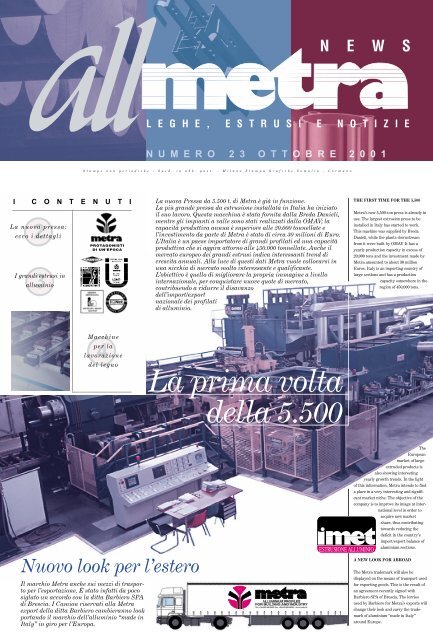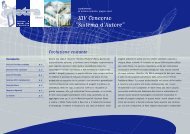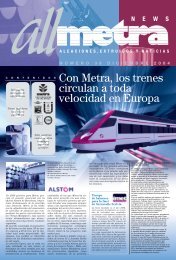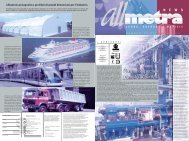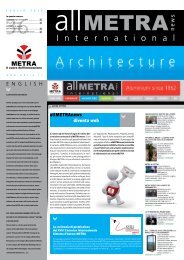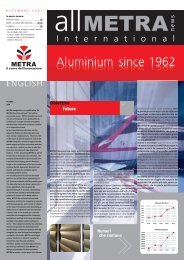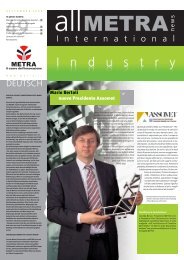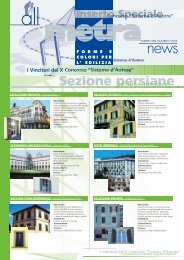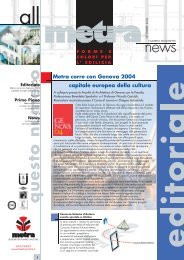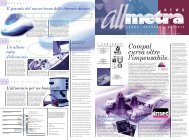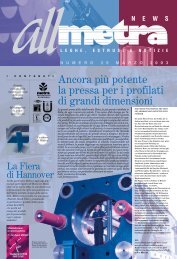Create successful ePaper yourself
Turn your PDF publications into a flip-book with our unique Google optimized e-Paper software.
N E W SL E G H E , E S T R U S I E N O T I Z I EN U M E R O 2 3 O T T O B R E 2 0 0 1S t a m p e n o n p e r i o d i c h e - S p e d . i n a b b . p o s t . - M i l a n o S t a m p a G r a f i c h e S o m a l i a - C o r m a n oI C O N T E N U T I2<strong>La</strong> nuova pressa:ecco i dettagli3I grandi estrusi inalluminioPROTAGONISTIDI UN’EPOCA<strong>La</strong> nuova Pressa da <strong>5.500</strong> t. di <strong>Metra</strong> è già in funzione.<strong>La</strong> più grande pressa da estrusione installata in Italia ha iniziatoil suo lavoro. Questa macchina è stata fornita dalla Breda Danieli,mentre gli impianti a valle sono stati realizzati dalla OMAV; lacapacità produttiva annua è superiore alle 20.000 tonnellate el’investimento da parte di <strong>Metra</strong> è stato di circa 30 milioni di Euro.L’Italia è un paese importatore di grandi profilati ed una capacitàproduttiva che si aggira attorno alle 450.000 tonnellate. Anche ilmercato europeo dei grandi estrusi indica interessanti trend dicrescita annuali. Alla luce di questi dati <strong>Metra</strong> vuole collocarsi inuna nicchia di mercato molto interessante e qualificante.L’obiettivo è quello di migliorare la propria immagine a livellointernazionale, per conquistare nuove quote di mercato,contribuendo a ridurre il disavanzodell’import/exportnazionale dei profilatidi alluminio.THE FIRST TIME FOR THE 5,500<strong>Metra</strong>’s new 5,500-ton press is already inuse. The largest extrusion press to beinstalled in Italy has started to work.This machine was supplied by BredaDanieli, while the plants downstreamfrom it were built by OMAV. It has ayearly production capacity in excess of20,000 tons and the investment made by<strong>Metra</strong> amounted to about 30 millionEuros. Italy is an importing country oflarge sections and has a productioncapacity somewhere in theregion of 450,000 tons.Macchineper4lalavorazionedel legno<strong>La</strong> <strong>prima</strong> <strong>volta</strong><strong>della</strong> <strong>5.500</strong>TheEuropeanmarket of largeextruded products isalso showing interestingyearly growth trends. In the lightof this information, <strong>Metra</strong> intends to finda place in a very interesting and significantmarket niche. The objective of thecompany is to improve its image at internationallevel in order toacquire new marketshare, thus contributingtowards reducing thedeficit in the country’simport/export balance ofaluminium sections.Nuovo look per l’esteroIl marchio <strong>Metra</strong> anche sui mezzi di trasportoper l’esportazione. È stato infatti da pocosiglato un accordo con la ditta Barbiero SPAdi Brescia. I Camion riservati alla <strong>Metra</strong>export <strong>della</strong> ditta Barbiero cambieranno lookportando il marchio dell’alluminio “made inItaly” in giro per l’Europa.A NEW LOOK FOR ABROADThe <strong>Metra</strong> trademark will also bedisplayed on the means of transport usedfor exporting goods. This is the result ofan agreement recently signed withBarbiero SPA of Brescia. The lorriesused by Barbiero for <strong>Metra</strong>’s exports willchange their look and carry the trademarkof aluminium “made in Italy”around Europe.
<strong>La</strong> nuova pressa:ecco i dettagli!TECHNOLOY OF THE 5,500-TONEXTRUSION SYSTEMTECNOLOGIA DELL’IMPIANTO DA ESTRUSIONEDA 5500 TONNELLATE• Weight of the press750 tons• Peso Pressa750 tonnellate• Pre-heating of the billets• Billets diameter• Container diameter• Billets weight• Billets length• Billet cutting method• Cooling tunnel• Length of extrusion bench• Puller• Drawing machine• Unloading of sections• Ageing furnace• Sections max. lengthQUALITY CONTROLIN THE EXTRUSION PROCESSgas furnace330 mm340 mm370 kg1600 mmhot shearsdifferentiated, withdemineralisedwater and air45 m(handling onKevlar belts)double250-ton capacitywith twister forgeometricalcorrectionautomatic26 metres,forced air25,900 mm• Extrudable alloys Classes 1000, 3000,6000 and 7000• Preriscaldamento Billette• Diametro Billetta• Diametro Contenitore• Peso Billetta• Lunghezza Billetta• Taglio Billetta• Tunnel di Raffreddamento• Lunghezza Banco Estrusione• Puller• Stiratrice• Scaricamento Profilati• Forno Invecchiamento• Lunghezza max. Profilatoforno a gas330 mm340 mm370 kg1600 mmcesoia a caldodifferenziato ad acquademineralizzata e aria45 mt (movimentazionecon nastri in kevlar)doppio250 ton con twister percorrezione geometricatorsionaleautomatico26 mt ad aria forzata25900 mm• Leghe Estrudibili classi 1000; 3000;6000; 7000CONTROLLI DI QUALITÀNEL PROCESSO DI ESTRUSIONE• Controllo <strong>della</strong> pressioned’estrusione• Misurazione <strong>della</strong> temperatura inentrata ed in uscita dal tunnel diraffreddamento con scanner laser ainfrarossi• Controllo dimensionale• Controllo di rettilinearità <strong>prima</strong> edopo la stiratrice• Prove ad ultrasuoni• Marchiatura dei profilati (su richiesta)• Controllo <strong>della</strong> struttura cristallinaCONTROLLI IN LABORATORIO• Prova di piegatura• Prova a trazione per il rilevamentodelle proprietà meccaniche• Macrografia• Controllo dimensionale con strumentitradizionali• Controllo dimensionale tramitescanner o proiettore elettronico• Controllo <strong>della</strong> rotondità per i tubitondi• Controllo <strong>della</strong> rugosità superficiale• Controllo <strong>della</strong> durezza superficiale• Control of the extrusion pressure• Measurement of the temperature on entering50and on leaving the cooling tunnel by means ofan infrared laser scanner• Dimensional checks• Straightness checks before and after thedrawing machine• Ultrasound testing• Marking of sections (on request)• Check of crystalline structureLABORATORY TESTS• Bending test• Tensile testing in order to determine themechanical properties of the product• Macrographs• Dimensional checks using traditionalinstruments• Dimensional checks using a scanner orelectronic projector• Roundness checks for round pipes• Surface roughness check• Surface hardness check.PESO Kg/m (peso al metro profilo per n° uscite3025201085,04,03,53,02,52,01,51,20,6P.1850 P.2200 P.2780 P.3200 P.5500Peso ottimalePeso estrudibileA PARITÀ DI PESOLA SCELTADELLA PRESSAÈ DETERMINATADAI SEGUENTI CRITERI:• diametro circoscritto del profilato• lega• condizioni commerciali(prezzo e quantità)• settore di utilizzo del profilatoN.B.: i valori sono indicativiThe third and last part of the article about thetram will be published in the next issue of All<strong>Metra</strong> News.All <strong>Metra</strong> NewsLeghe, estrusi e notizie<strong>La</strong> terza e ultima partedell’articolo sul tramverrà pubblicatonel prossimo numerodi All <strong>Metra</strong> News.Stampe non PeriodicheSpedizione in Abbonamento PostaleMilanoStampa Grafiche SomaliaCoordinamento editorialee art directionPartners in Business Communications
A L L U M I N I O P R O T A G O N I S T AI grandiestrusiin alluminioALCUNI SETTORI TIPICIDEI GRANDI ESTRUSI IN ALLUMINIO• Treni• Macchine utensili• Tram• Piattaforme• Autobus• Pedane• Camion• Dissipatori• Dumpers• Profili per facciate e strutture di grattacieli• Rampe caricamento• Barrame per torneria o stampaggio• Navi da crociera• Pale frangisole• Navi da trasporto•Profilati strutturali in genere• Barche a vela• Capannoni e coperture• Sponde montacarichiMa quali sono le motivazioni cheportano i progettisti e gli utilizzatori arichiedere i grandi estrusi? E quali sonoi principali settori di impiego? In primoluogo il progettista ed il Cliente possonotrarre dai grandi profilati i seguenti vantaggi:• Riduzione dei tempi di progettazione. Nonservono studi complessi di assemblaggio fracomponenti di non facile reperibilità o didifficile costruzione; per esempio lamierepiegate o profilati in acciaio saldato.• Riduzione dei costi di produzione. Il profilato grande riduce il numero delle saldature necessarieper ottenere strutture complesse.• Aumento delle possibilità progettuali. I limiti dimensionali imposti dagli estrusori, hannosicuramente ridotto l’utilizzo degli estrusi per certe tipologie di prodotti.• Semplificazione e robustezza dei manufatti. Profilati con meno nodi e giunti di assemblaggio sonosicuramente più robusti ed affidabili nel tempo.• Alleggerimento delle strutture. Meno giunzioni semplificano ed alleggeriscono i profilati,migliorando le caratteristiche complessive del manufatto da realizzare.Per quanto riguarda invece i principali settori di utilizzo dei grandi estrusi, a tal proposito virimandiamo al box a fondo pagina, il più importante riguarda il trasporto in generale (su rotaia, sugomma e navale). Nel settore ferroviario è da tempo in atto una profonda ristrutturazione del parcocarrozze circolanti. <strong>La</strong> competizione in termini di tempi di percorrenza fra il treno e l’aereo è semprepiù forte. L’aumento <strong>della</strong> velocità con i moderni treni superveloci passa necessariamentedall’alleggerimento <strong>della</strong> carrozza, a parità di performances in termini di stabilità e sicurezza.Le strutture portanti dei treni moderni sono realizzate con estrusi di grandi dimensioni.Le stesse motivazioni valgono per il trasporto su gomma e navale. Nel primo caso è da aggiungereche la riduzione dei pesi del veicolo con maggiore capacità di carico, comporta proporzionaliriduzioni dei consumi. Nel caso del trasporto navale il teorema enunciato è fondamentale: naviveloci = strutture più leggere = estrusi in alluminio di grandi dimensioni.LARGE ALUMINIUM EXTRUSIONSBut why should designers and users ask for largeextrusions? Designers and customers can benefitfrom using large extrusions in the following ways:• Shorter design times. There is no need forcomplex studies for fitting together componentsthat would not be easy to procure or would bedifficult to make. Examples of these are bendedsheets or welded steel sections.• Lower production costs. A large section reducesthe number of welds required to obtain acomplete structure.• More design options. The size limits set byextruders have definitely reduced the use ofextrusions for certain product typologies.• Simpler and stronger manufactured items.Sections with a smaller number of nodes andassembly joints are undoubtedly tougher andmore reliable in time.• Lighter structures. A smaller number of jointssimplifies the sections and makes them lighter,thus improving the characteristics of themanufactured item to be made as a whole.As far as concerns the main fields of use of largeextrusions, on the other hand, the most importantconcerns transport in general (transport by rail,road and ship). A deep-reaching re-organisationof the rolling stock in use has been going on forsome time in the railway sector. Competitionbetween trains and aeroplanes in terms of travellingtimes has been getting fiercer. In order toincrease the speed of modern super-fast trains,making the carriages lighter is a must, but maintainingthe same performance in terms of stabilityand safety. The load-bearing structures of moderntrains are made with large extrusions. The sameexplanations apply to transport by road and byship. With reference to the former, it must also beadded that lowering the weight of the vehicle andgiving it a greater payload leads to proportionalcuts in consumption. In the case of transport byship, the theorem is essential: fast ships =lighter structures = large aluminium extrusions.SOME TYPICAL SECTORS IN WHICHLARGE ALUMINIUM EXTRUSIONSARE USED• Trains• Trams• Buses• Tracks• Dumpers• Loading ramps• Cruise ships• Freight ships• Sailing boats• Elevator platforms• Machine-tools• Platforms• Foot boards• Heat sinks• Sections for skyscraper façades and structures• Bars for turning or moulding• Sun-blades• Structural sections in general• Sheds and roofing
I N D U S T R I AMacchine perla lavorazione del legnoQuesto tipo di profilato viene utilizzatonelle macchine per la lavorazione dellegno. È un estruso di dimensioni particolarmentesignificative e di sagomacomplessa, 443 mm di larghezza per210 mm di altezza prodotto in lega6060 T5.<strong>La</strong> necessità di avere un piano di lavorolargo per la lavorazione dei pezzigrandi è risolta dall’uso di un monoprofilodi grandi dimensioni.<strong>La</strong> forma di questo profilo riduce ilnumero di componenti <strong>della</strong> macchinasemplificandola e irrobustendola.Foto: Biesse443 x 210 mmpeso 28,400 Kg/mlT R A S P O R T IWOODWORKING MACHINESSponde montacarichi525 x 39,5 mmpeso 20,320 Kg/mlThis type of section is used in woodworkingmachines. It is a particularly large extrusion andhas a complex shape. It is 443 mm wide by 210mm high and is made of 6060 T5 alloy. The needUna sponda montacarichi deve essererobusta, resistente e leggera. L’utilizzodi un minor numero di profilati, attraversol’impiego di estrusi di grandidimensioni, riduce le saldature e giun-ture incrementando la robustezza delmanufatto. L’alleggerimento ottenutocontribuisce a ridurre lo sforzo idraulicodurante il caricamento consentendodi aumentare il peso sollevabile.Oltretutto il diminuire delle operazionicomporta una sostanziale riduzione deicosti del prodottofinale. <strong>La</strong>lega utilizzataè normalmentela6005/A.Foto: Avifor a wide bench so as to be able to machine largeworkpieces is met by using a single large section.The shape of this section lowers the number ofcomponents of the machine, making it simplerand stronger.Photo: BiesseELEVATOR PLATFORMSA U T O M A Z I O N EThe side panels of a hoist must be strong, resistantand light. Using a smaller number of sectionsthanks to large extrusions means a smallernumber of welds and joints and increases theAttuatori pneumaticistrength of the product. The reduction of weightthat is achieved also contributes towards loweringthe hydraulic effort during loading, so that grea-260 x 300 Ø int. 240 mmpeso 61,00 Kg/mlL’attuatore pneumatico è una componentelargamente utilizzata nel campodell’automazione per l’apertura e chiusuradi porte o movimenti in genere. Ilprofilato già realizzato per questa tipologiadi prodotto pesa circa 60 Kg inlega 6063 T5 e ha dimensioni 260x300mm. Le dimensioni di questo estrusosono molto importanti, ma l’attualepressa da 5500 tonnellate è in grado direalizzare profilati tubolari di dimensioniancora maggiori! Si possonoinfatti produrre tubi quadri fino a300x300 mm e tubi tondi fino a 350 mmdi diametro!ter weights can be lifted.What is more, the smaller number of operationsmeans substantial savings on the costs of the endproduct. The alloy normally used is 6005/A.Photo: AviPNEUMATIC ACTUATORSPneumatic actuators are widely used componentsCOGNOME E NOMEAZIENDADIVISIONEINDIRIZZOCAP CITTÀNº TELEFONODESIDERO RICEVEREINFORMAZIONI SU METRASUGGERISCO UN INCONTRO IL (data)ALLE (ore)RICHIEDO MATERIALEINFORMATIVO SULLE VOSTRE ATTIVITÀ.I SOGGETTI CHE MI INTERESSANOSONO I SEGUENTI:PROFILATI A DISEGNOFINITURE (verniciature, ossidazioni)LAVORAZIONI MECCANICHE(fresature, curvature)ALTRO (specificare)<strong>Metra</strong> s.p.a. garantisce la massima riservatezzadei dati forniti e la possibilità di richiederne la rettificao la cancellazione scrivendo a METRAS.P.A. via Stacca,1 - 25050 RODENGO SAIANO(BS). I dati verranno utilizzati al solo scopo diinviarle proposte commerciali. In conformità allalegge 675/96 sulla tutela dei dati personali.COUPON DA COMPILARE E SPEDIRE A:METRA S.P.A.VIA STACCA, 125050 RODENGO SAIANO (BRESCIA)ITALYN. FAX +39/30/6819991http://www.metra.itin the field of automation for opening and closingdoors and many other types of movement. Thesection already made for this product typologyweighs about 60 kg and is made of 6063 T5 alloy.It measures 260 x 300 mm. The dimensions of thisextrusion are particularly significant, however thecurrent 5,500-ton press is able to make even largertubular sections! It is possible to producesquare tubular sections with cross-sections of upto 300x300 mm and round ones with diameters ofE.mail: industry@metra.itup to 350 mm!


